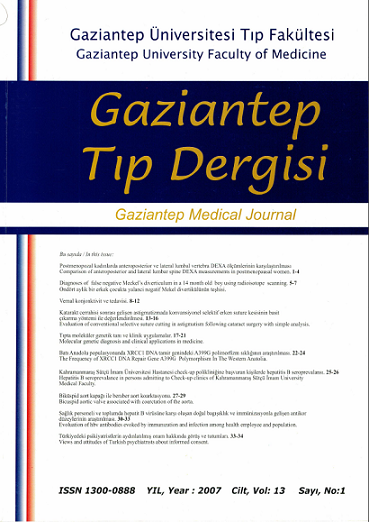Evoluation of HBV Antibodies Evoked by Immunization And Infection Among Health Employee and Population
DOI:
https://doi.org/10.58600/eurjther.2007-13-1-1410-archKeywords:
Hepatitis B virus, Seroprevalence, ImmunizationAbstract
In present study HBV-markers (HBs Ag and Anti HBs) were investigated in two different groups. HBV antibodies evoked by immunization and infection in health employees and population were researched and compared each other. From January 1998 to January 2000 we investigated hepatitis B virus markers (HBS Ag and Anti HBs) by ELISA technique (Bioelisa, Biokit S.A., Spain) in total of 248 persons, 100 from normal population and 148 from healthy hospital employees. Following detection of HBV markers, HBV vaccine (GenHevac B, Pasteur) was administered in 96 subjects with being seronegative of HBs Ag and Anti HBs. Serum samples were collected on the 30th days of postvaccination for Anti HBs response. In the group of healthy hospital employees, the frequency of positivity for HBs Ag and Anti HBs antibodies was 35.14 % (52 of 148) and 5.41 % (8 of 148) respectively. At the same time HBs Ag and Anti HBs positivity were 5 % (5 of 100) and 26 % (26 of 100) in healthy population. There weren't any immunization occur after the first dose of vaccination. One month after the second dose, 3 subjects of hospital employees and one subject of healthy population and one month after the third dose, almost all subjects (except one in hospital employees) were being seroprotected. Hepatitis B virus is a common viral agent; so vaccination has been seemed to be necessary in order to eradicate Hepatitis B infection. The vaccine should be applied at high risk groups especially in health workers before beginning working. In this study it has been shown that the first and second dose of vaccine were insufficient in developing Anti HBs antibodies. In conclusion three doses immunization course against HBV were necessary to elicit protective levels of Anti HBs antibodies.
Metrics
References
Tabak F. Virüs Hepatitlerinin Epidemiyolojisi. Yücel A., Tabak F. (eds.) Günümüzde Virüs Hepatitleri kitabında. İstanbul Bulaşıcı Hastalıklarla Savaş Derneği, 1998:11 s:21-30.
Yenen Ş. Willke A, Doğanay M, Söyletir G. (ed.). Viral hepatitler. İnfeksiyon Hastalıkları kitabında, Nobel Tıp Kitabevi, 1996:s:2.
Purcell RH. The discovery of the hepatitis viruses. Gastroenterology 1993;104:955-63.
Lee WM. Hepatitis B virus Infection. NEnglJMed 1997; Dec. 11 vol.337, No.24:1733-45.
Taşyaran M. Epidemiyoloji. Kılıçturgay K.(ed.) Viral hepatit 1998 kitabında. Viral Hepatitle Savaşım Derneği Yayını 1998; s.97.
Kaur S, Rybicki L, Bacon BR, Gallon JL, Rusg VK, Grey WD. Performance characteristics and results of a large-scale screening program for viral hepatitis and risk factors associated with expousre to viral hepatitis B and C: results of the National Hepatitis Screening Survey National Hepatitis Surveillance Group. Hepatology 1996; Nov. 24(5):979-986.
Flores Castaneda MS, Garcia Mandez BL, Tijerna Menchaca R. HCV and HBV seropositivity in university students of the state of Nuevo Leon Mexico. Rev. Gastroenterol Mex. 1996; Oct. Dec. 61(4):327-31.
Mıstık R., Balık İ. Türkiye'de Viral Hepatitlerin Epidemiyolojik Analizi. Kılıçturgay K.,Badur S.(ed.).Viral hepatit 2001 kitabında, Viral Hepatitle Savaşım Derneği Yayını 2001;s:10-55.
Aydın ON., Aydın N.,Ünal F. Opere Edilecek Hastalarda HBs Ag, anti HCV ve anti HIV Pozitifliği ve Korunma. Türk Mikrobiyoloji Cemiyeti Dergisi, 1999;29:78-81.
Sırmatel F, Balcı İ, Karaoğlu I. Karataş M. Değişik toplumlarda Hepatit B yüzey antijen taşıyıcılığı. Viral Hepatit Dergisi 1996; 2(2) : 89-92.
Dökmetaş İ, Yalçın AN, Bakır M, Poyraz Ö, Elaldı N, Yalman N. Sağlık Personelinde Hepatit B ve C Seroprevalansı. Mikrobiyoloji Bülteni 1995; 29 : 278-283.
Türkdoğan MK, Berktaş M, Tuncer İ ve ark.. Van Bölgesinde Viral Hepatit B Seroepidemiyolojisi. Viral Hepatit Dergisi 1996;1:38-39.
Güven R, Bozdemir N. Bayındır Tıp Merkezi Sağlık Personelinde HBs Ag ve Anti HBs Taraması ve Aşılama Sonuçları. IX. Türk Klinik Mirobiyoloji ve İnfeksiyon Hastalıkları Kongresi, Antalya, Kongre Kitabı 1999;s. 239.
Koşar A, Sünbül M, Saniç A, Alıcı S. Tıp Öğrencileri ve Sağlık Personelinde HBs Ag ve Anti HBs pozitifliği. Mikrobiyoloji Bülteni 1995;29:52-57.
Sarıtaş Ü, Kantaroğlu M, Yıldırım B, Saydam G, Yılmaz U. Türkiye Yüksek İhtisas Hastanesi Sağlık Personelinde HBV Prevalansı. Gastroenteroloji 1994;5:147-148.
Wang YM, NG WC, Kang JY, Yap I,Seet BL, Teo J, Smith R, Gwan R. Serolojical profiles of hepatitis B carriers patients in Singapore with special reference to the frequency and significance of concurrent presence of HBs Ag and anti HBs. Singapore MedJ, Apr. 1996; 37(2):150-2.
Kurt H, Türçapar N, Balık İ, Tekeli ME, Meço O. Yüksek Risk Grubunda Olan Sağlık Çalışanlarında Viral Hepatit (A, B, C, D) Enfeksiyon Sıklığı. Viral Hepatit Dergisi 1997;1,1:56-57.
Bektaş M, Dalkılıç E, Yavuz T, Bozkurt H, Akdeniz H, Türkdoğan K, Irmak H. YYÜ Tıp Fakültesi Araştırma Hastanesi Personelinde Hepatit B seroprevalansı. Viral Hepatit Dergisi 1995;(2):87-89.
Pahsa A, Erdemoğlu AG, Özsoy MF, Emekdaş G, Özer MT, Kocabeyoğlu Ö. Sağlık Çalışanlarında Hepatit B ve C Seroprevalansı. IX. Türk Klinik Mikrobiyoloji ve İnfeksiyon Hastalıkları Kongresi, Antalya, Kongre kitabı 1999; s.234.
Tekeli E. Korunma. Kılıçturgay K, Badur S. (eds.) Viral hepatit 2001 kitabında. Viral Hepatitle Savaşım Derneği Yayını 2001;s.174-177.
Onag A., Bakkaloğlu B, Oksel F, Vurgun N, Taneli B. Düşük Doz Hepatit B Aşılaması ve Sonuçları. Viral Hepatit Dergisi 1996; (2),1 s.19-22.
Hızel K, Şengül A, Emekdaş G, Şenol E, İnal A. Hastane Personelinde Hepatit B Seroprevalansı ve Rekombinant Hepatit B Aşısına İmmün Cevap. Viral Hepatit Dergisi 1998; (4),1 s.25-27.
Hess G, Hingst V, Cseke J, Bock H, Clemens R. Influence of vaccination schdules and host factors on antibody response following hepatitis B vaccination. Eur. J Clin Microbiol Infect Dis 1992;11,p.334-340.
Downloads
Published
How to Cite
Issue
Section
License
Copyright (c) 2023 European Journal of Therapeutics

This work is licensed under a Creative Commons Attribution-NonCommercial 4.0 International License.
The content of this journal is licensed under a Creative Commons Attribution-NonCommercial 4.0 International License.


















